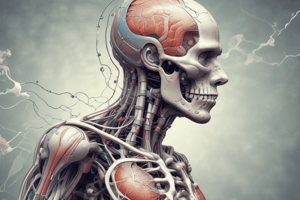Podcast
Questions and Answers
What percentage of calcium in the body is primarily found in bone?
What percentage of calcium in the body is primarily found in bone?
- 1%
- 99% (correct)
- 50%
- 75%
Which form accounts for the highest percentage of calcium in the blood?
Which form accounts for the highest percentage of calcium in the blood?
- Bound to anions
- Bound to proteins
- In bone tissue
- Free Ca2+ ions (ionized Ca2+) (correct)
Why is the concentration of ionized Ca2+ in blood significantly higher than in the cytosol of muscle cells?
Why is the concentration of ionized Ca2+ in blood significantly higher than in the cytosol of muscle cells?
- Calcium is mostly stored in the cytosol.
- Calcium only plays a role in bone formation.
- Muscle cells do not require calcium.
- A large gradient is maintained for calcium flux. (correct)
Which of the following is NOT a form that calcium in blood is distributed among?
Which of the following is NOT a form that calcium in blood is distributed among?
What change can dramatically affect calcium concentrations during critical care?
What change can dramatically affect calcium concentrations during critical care?
Flashcards
Calcium Distribution in the Body
Calcium Distribution in the Body
The majority of calcium in the body (99%) is found within bones, with the remaining 1% circulating in the blood and other bodily fluids.
Calcium Gradient between Blood and Muscle Cells
Calcium Gradient between Blood and Muscle Cells
The concentration of ionized calcium (Ca2+) in the blood is significantly higher (5,000 to 10,000 times) than in the cytosol of muscle cells.
Distribution of Calcium in Blood
Distribution of Calcium in Blood
About 45% of calcium in the blood is free in the form of ionized calcium (Ca2+), 40% is bound to proteins, mostly albumin, and 15% is bound to anions like HCO3-, citrate, PO4-, and lactate.
Variations in Calcium Distribution during Illness
Variations in Calcium Distribution during Illness
Signup and view all the flashcards
Reliability of Total Calcium Measurements during Illness
Reliability of Total Calcium Measurements during Illness
Signup and view all the flashcards
Study Notes
Calcium Distribution in the Body
- Approximately 99% of body calcium is found in bone.
- The remaining 1% is primarily in blood and other extracellular fluid (ECF).
- Intracellular calcium (cytosol) is very low in most cells.
- Blood ionized calcium concentration is significantly higher than in cardiac or smooth muscle cells (5,000-10,000 times greater).
- This large gradient is crucial for rapid calcium influx.
Forms of Blood Calcium
- 45% of blood calcium is free ionized calcium.
- 40% is bound to protein, mainly albumin.
- 15% is bound to anions like bicarbonate, citrate, phosphate, and lactate.
Calcium Measurement Considerations
- Blood calcium levels are affected by factors like citrate, bicarbonate, lactate, phosphate, and albumin concentrations.
- These factors can significantly fluctuate in conditions like critical illness or surgery.
- Consequently, total calcium levels are not a reliable predictor of ionized calcium, particularly in acutely ill patients.
Studying That Suits You
Use AI to generate personalized quizzes and flashcards to suit your learning preferences.




